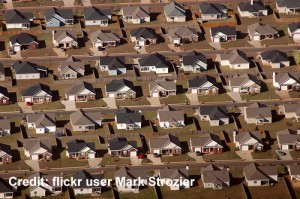Race to the Middle: What the Homogenization of Population Density is Costing New Jersey
Over the past 50 years, New Jersey has moved away from both the compact urban and open rural densities which laid the foundation for today’s high quality of life and made our state unique.
Instead, we have engaged in a “race for the middle” of the density scale. The spread-out developments proliferating today across the state’s midsection are wasteful of land, money, and time, and are generating costs that will make demands on New Jersey’s taxpayers for decades to come.
- Exurban densities dedicate large amounts of land to relatively few residents. Whereas older, compact communities like Princeton could theoretically house the entire state’s population using only 15 percent of its land, exurban places like Montgomery, Raritan and Harrison townships would require two to three times the state’s land area to house the same population. With an expected one million new residents coming to New Jersey by 2020, such exurban densities are not only wasteful, but unsustainable.
- Exurban densities cost more to serve. Compact densities mean more residents share the costs of roads, sewers and other public services such as schools. Whereas in densely populated Hudson County only one mile of road is required to serve 1,000 residents, it takes 11 miles of road to serve 1,000 residents in sprawling Hunterdon County. The provision of infrastructure to low-density areas is often subsidized by taxpayers elsewhere in the county or state.
- Exurban densities waste more time in travel. Annual hours of traffic delay are actually lower in more densely designed urban areas, where other options for travel
become feasible, including walking and public transit. Increases in density initially can lead to more traffic, but at some point higher densities actually alleviate traffic congestion.
Reversing the drift toward density’s middle ground will involve down-zoning in some places and upzoning in others. Changes to the municipal land use law are also needed, to help municipalities better plan for and manage growth. The State Plan stands ready as a guide in determining what density and zoning changes are appropriate for what areas and in identifying the areas that are most appropriate for absorbing new growth.
It is precisely the lack of compact density in our most recent development that is propelling us so rapidly towards build-out. We must be smarter about how we use our remaining buildable land and arrest the state’s degeneration into inefficient middle-range densities. New Jersey is not full yet, but that day is fast approaching unless we reclaim the advantages of our historic density patterns and relearn the wisdom of building higher-density, pedestrian-friendly, mixed-use communities.
Download report:
Race to the Middle:
The Homogenization of Population Density and What It’s Costing New Jersey (PDF)












